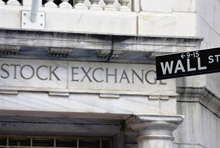
Typical street scene in Santa Ana, El Salvador. (Photo: iStock)
IMF Survey: Strong Credit Growth, Asset Price Hikes Can Signal Financial Risks
September 13, 2011
- Knowing what drives rapid credit growth key to right policy response
- Credit growth signals risk build-up for variety of countries
- Helps countries identify and lessen risks to financial system
Rapid credit growth, increased asset prices, greater reliance on banks’ foreign borrowing, and an appreciating currency are signs a country could be headed for a financial crisis, according the IMF’s latest analysis.

Understanding how financial crises effect a country’s economy can help policymakers fix the problem (photo: William Manning/Corbis)
GLOBAL FINANCIAL STABILITY REPORT
In the wake of the global economic crisis, which began as a financial crisis in the United States in 2008, this new research, part of the IMF’s Global Financial Stability Report, provides countries a practical framework to help them spot potential trouble on the financial horizon, and choose the best policy to respond.
Credit growth is the result of either a good shock to the economy, such as increased productivity, or a bad shock, such as real estate bubbles that led to the most recent global crisis. Other indicators need to accompany credit growth for policymakers to distinguish between the two types of shocks.
The same indicators also work across different exchange rate regimes, which means a wide range of countries are able to use the indicators to help spot a potential crisis. The IMF tested a variety of models across a large sample of countries, including advanced and emerging economies.
“We first try to better understand, through a model that accounts for the interaction between the financial sector and the economy, which indicators and what types of shocks give rise to systemic risk; then we use these insights to find indicators to help us predict when risks are building up,” said Laura Kodres, chief of global stability analysis in the IMF’s Monetary and Capital Markets Department, in a press conference to launch the study.
These latest findings are part of the IMF’s ongoing work on macroprudential policy to help countries identify risks to the whole financial system, not just individual firms.
Macroprudential policy helps countries lessen the chances of a crisis or soften its blow through a wide range of systemic risk indicators—that is, indicators that gauge risks to the whole financial system, rather than those affecting individual banks. These include areas such as the resilience of the financial system to shocks, the availability of money in financial markets, the connections between financial institutions, private sector debt, and international capital flows.
All shocks are not created equal
Understanding the source of shocks and how they are transmitted from the financial and banking system to a country’s economy is key to finding the right tools to monitor the build-up of risk in a country’s financial system.
According to the IMF’s research, when the credit-to-GDP ratio increases more than 5 percentage points per year, and is accompanied by equity price rises of 15 percent or more, the chance of a financial crisis within the next two years is 20 percent.
The research also tested a wide variety of high-frequency financial market price-based indicators that could inform policymakers when the materialization of systemic risk is imminent. Even though a few of these indicators could signal a crisis is coming within a few months, their ability to detect potentially dangerous connections among financial institutions did not fare well. The IMF said the indicators tested did not reliably predict the failures of investment banks such as Bear Stearns or Lehman Brothers.
The IMF said their research found that a similar set of tools to identify risks to the financial system and track their build-up can be effective across a number of countries with both fixed and flexible exchange rate regimes. But the tools need to be designed differently in managed exchange rate regimes with widespread foreign-currency lending.
The IMF will release its latest assessments in the Global Financial Stability Report on September 21 and the World Economic Outlook on September 20, both in Washington, D.C.


